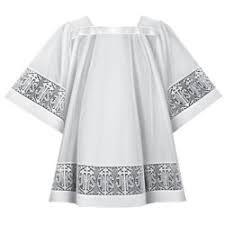

Q. 1. What is a Pastoral Staff and what is it used for?
A. 1. The surplice, like the rochet, is a knee-length, white vestment worn over the choir cassock, but by priests, deacons, and seminarians rather than bishops. It is typically simple in design, but can be very fancy. It is distinct from the rochet not in the level of decoration, but in the sleeve: the sleeve of a rochet, like an alb, fits flush against the choir cassock; the sleeve of a surplice is fuller, and often bell-shaped.
From Wikipedia, we read:
In the Roman tradition, the surplice (or "cotta") sometimes features lace decoration or embroidered bordures.
The surplice is meant to be a miniature alb, the alb itself being the symbol of the white garment received at Baptism. As such, it is appropriately worn by any cleric, by lectors and acolytes, or indeed by altar servers who are technically standing in for instituted acolytes for any liturgical service. It is often worn, for instance, by seminarians when attending Mass and by non-clerical choirs. It is usually worn over a cassock and never alone, nor is it ever gathered by a belt or cincture.
It may be worn under a stole by deacons and priests for liturgical ceremonies or the celebration of sacraments outside of Mass. On occasion, a cope is worn over the cassock, surplice and stole.
As part of the choir dress of the clergy, it is normally not worn by prelates (the pope, cardinals, bishops, monsignori, and some canons) - instead, these clerics wear the rochet, which is in fact a variant of the surplice.
The surplice belongs to the vestes sacrae (sacred vestments), though it requires no benediction before it is worn.
[Source: https://en.wikipedia.org/wiki/Surplice]